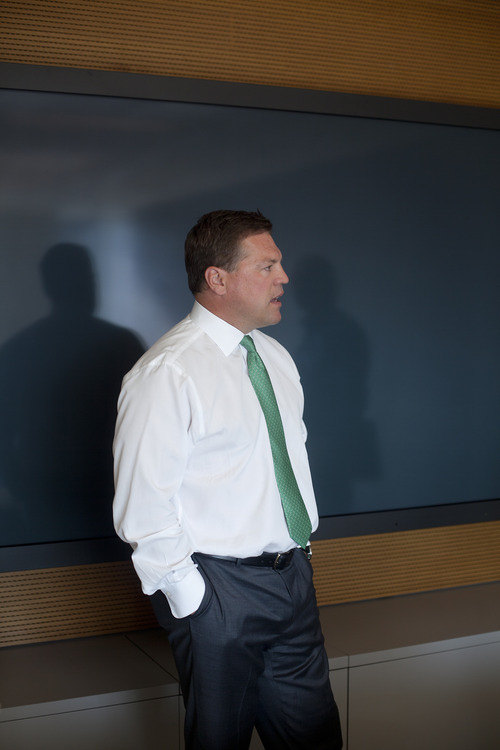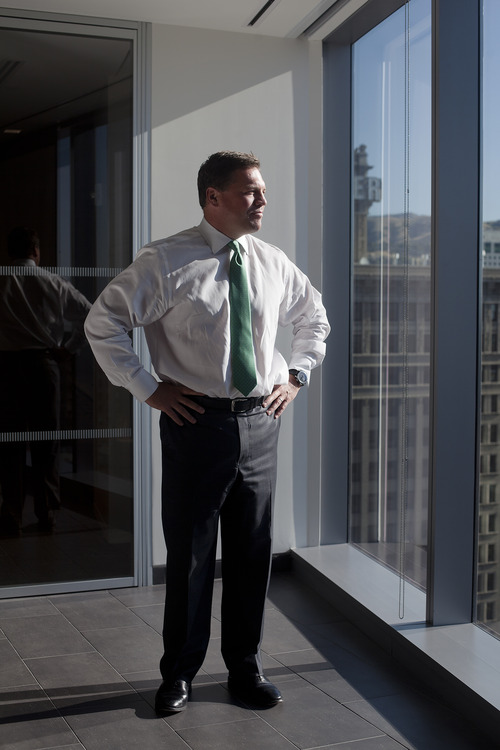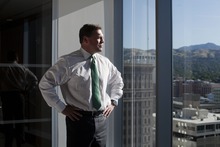This is an archived article that was published on sltrib.com in 2013, and information in the article may be outdated. It is provided only for personal research purposes and may not be reprinted.
Two nights before Halloween last year, a massive wall of sandbags surrounding Goldman Sachs' steel and glass headquarters in lower Manhattan stood as the global investment bank's last defense against a tide of storm water pushed inland by Hurricane Sandy. Across the Hudson River, 8 feet of water lapped against sandbags stacked outside Goldman's tower in Jersey City, N.J.
More than 10,000 Goldman employees were cut off from their jobs by the massive storm as it swirled across the region, forcing the New York Stock Exchange to halt all trading operations, causing the Port Authority of New York and New Jersey to suspend train service and cutting power to millions of customers.
Dire as the conditions were, Goldman was not without resources to keep its global business running.
"We've got a very large building and very large operations in Salt Lake City," Gary Cohn, Goldman's president and chief operating officer, assured interviewers on Bloomberg TV a day later. "We've got [hundreds of] people in Salt Lake City that can carry on many if not all of the operations of Goldman Sachs as well."
And, Cohn quipped, "that's definitely in a complete different weather pattern."
Utah's capital is fast becoming Wall Street's Western outpost and the world's biggest investment bank is its poster boy. The number of Goldman employees in Utah's capital, split between seven floors at 222 S. Main St. and a 75,000-square-foot space on Chipeta Way near the University of Utah, is 1,775 people. Over 10 weeks this summer, that number was augmented by 274 college interns and, if history is a guide, Goldman will hire most of them.
Today, 13 years after Goldman established a foothold in Utah, Salt Lake City is the firm's fourth-largest location in the world, behind New York-New Jersey; London; and Bangalore, India's technology capital. While Sandy raged, Salt Lake City was "front and center," said managing director David Lang. "We were able to keep the lights on as a firm because of our Salt Lake City office."
Like an accelerating race car, the growth of Goldman in Salt Lake City is more and more rapid every year. In an interview, Lang wouldn't provide firm numbers, but six years ago Goldman's local workforce was fewer than 300. Next year, the count could be close to 2,000. Many of the new hires will be graduates of Brigham Young University and the University of Utah. BYU provides more graduates to Goldman than any other university in the U.S. The U. is in the top five.
"It's an exponential line," Lang said, "the growth is exponential."
Lang is a 20-year veteran of Goldman. Originally from Buffalo, N.Y., he joined the company as a summer intern in 1993. During the next two decades, he worked his way up to his present post, moving back and forth between New York and Tokyo until he took on the top job in Salt Lake City in 2008.
—
From Bangalore to Utah • Lang portrays Goldman's growth to prominence in Utah as a happy accident. Someone Goldman had hired to run its new online brokerage business persuaded her bosses to put the client-service operations in Salt Lake City. An office opened on Chipeta Way in 2000. But what seemed a good idea at the time never took off. The dot-com bubble crash in 2001 soured many retail investors on electronic trading, and Goldman pulled away from the business.
The company stayed in town but kept a low profile. For several years, the main duty of the office was to support the company's private wealth business by setting up client accounts and solving problems. Because several employees spoke Portuguese, the office had a hand in building software that buttressed a push into Brazil's private wealth market. Back-office staff also supported Goldman's industrial loan bank operations.
At the same time, Goldman was moving a lot of jobs away from traditional — and expensive — financial centers such as New York, London and Tokyo. The company opened an office in Singapore. The Bangalore office grew to more than 4,500 employees, more than half of whom are software developers hired from India's top universities. Because Bangalore was so successful, Goldman looked across the world to see where else it could grow. In 2008, the company decided to launch a major expansion in Utah.
Five years later, "we've grown from one division in the firm [and] 275 people to 1,775 people. Today, nine of the [company's] 11 divisions are represented," Lang told the board of directors of the Governor's Office of Economic Development earlier this month.
"Pretty much every activity or any activity that happens within Goldman Sachs is happening here in Salt Lake City," he told the delighted GOED board.
—
Critics and questions • Goldman may feel welcome in Utah, but the company has lots of critics elsewhere. On the day he resigned last year, a Goldman executive director and vice president published in The New York Times what he termed a "wake-up call" to the board of directors. Greg Smith said Goldman's "toxic and destructive" culture no longer put the interests of its clients ahead of the firm and that Cohn and CEO Lloyd Blankfein had "lost control" of the traditions that had made one of the world's most important banks great.
Two years earlier, Rolling Stone magazine printed a lengthy polemic by journalist Matt Taibbi, who called "the world's most powerful investment bank" a "great vampire squid" that had brought about every major market gyration since the Great Depression of the 1930s.
In the wake of the 2008 financial crisis, these and similar accusations touched a nerve in the U.S. They even led some business journalists to speculate that Goldman Sachs came to heavily Mormon, business-friendly Salt Lake City to escape the animosity.
"Here is this city down in the mountains that just doesn't understand why on earth there is all this anger toward Goldman Sachs," Reuters reporter Katya Wachtel said last year in a video posted on YouTube.
Some of that disdain was on display in Salt Lake City. Late in 2011, dozens of protesters and onlookers gathered on the sidewalk outside the Main Street building for a street-theater performance that chided Goldman for its "sins of manipulating the market during the dot-com bubble." The event was part of a nationwide series of rallies organized by Occupy Wall Street.
"What you read in the newspaper is that they are a titan, they have a lot of money, and they pay large bonuses and they get what they want. That's not the Goldman that we know in Utah," said Spencer Eccles, GOED's executive director.
Goldman isn't blind to its critics. In May, at its annual meeting in Salt Lake City — its first-ever outside New York — the firm released a report detailing actions it has taken to improve its business practices after a series of embarrassing blunders that stained its reputation in the aftermath of the financial crisis. CEO Blankfein announced publication of the report, which makes more than three dozen recommendations for change, covering client service, financial products it sells and employee incentives. The changes were implemented in February.
—
Colleges and community • But for many Utahns, Goldman is nothing but good. The U. places about 25 graduates and 40 interns a year at Goldman. BYU's business school has provided 77 graduates to Goldman in the past three years, and 216 former students list the firm as their current employer, according to the university's LinkedIn page. Kim Smith, a BYU finance professor who worked at Goldman for 28 years, said the firm hires students from every college and department across the university — not just the business school — because it likes the product.
"I know BYU best, and I know BYU students now are much better than they would have been 20 years ago," Smith said. "Goldman Sachs has always been willing to go wherever it can to find talented, quality people. The fact that they've come here means that's what they've found."
Through the years, the company has become part of the city's fabric. By some estimates, Goldman employees serve on the boards of more than 20 local nonprofits. Lang said many employees live and shop within walking distance of the downtown office. And with the firm planning more growth, there may be a Goldman campus downtown in a couple of years that includes a yet-to-be-constructed building, he said.
In May, 33 Utah small-business owners were the first class to graduate from Goldman Sachs' 10,000 Small Businesses program, an educational initiative that aims to create jobs and spur growth in the state and elsewhere in the U.S. Many of the graduates said the training had already allowed them to hire more workers.
In June, Goldman loaned $4.6 million to United Way of Salt Lake, which oversees the Utah High Quality Preschool Program. The loan, which Goldman calls a "social impact bond," will support preschool programs that prepare 3- and 4-year-olds in the Granite and Park City school districts for kindergarten. The firm is betting that the program will reduce the need for remedial-education programs later on, and the savings will be enough to repay the loan.
"They are investing in Utah because they believe in Utah," GOED's Eccles said. "That gets everybody's attention, whether they are tourists or whether they are businesses. And that's a great thing for Salt Lake and for Utah."
Twitter: @sltribpaul —
Goldman Sachs in Salt Lake City
• The company has been here since 2000. Significant growth began in 2008.
• 1,775 employees today, almost 6 percent of its global workforce of 30,000.
• Nine of 11 divisions are here: finance, compliance, global investment research, human capital management, investment banking, investment management, operations, services, technology.
• Second-largest U.S. location; No. 4 in the world.
• In May, Goldman held its first annual shareholders meeting at its downtown Salt Lake City office. It was first annual meeting outside New York since Goldman became a public company in 1999.









